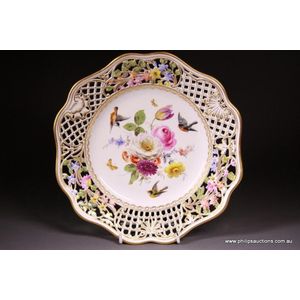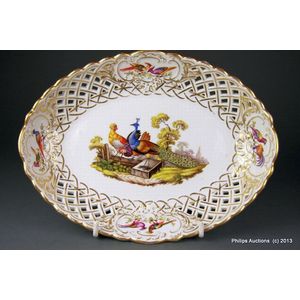Meissen Reticulated Dish with Peacock Scenes
You must be a subscriber, and be logged in to view price and dealer details.
Subscribe Now to view actual auction price for this item
When you subscribe, you have the option of setting the currency in which to display prices to $Au, $US, $NZ or Stg.
- Basket Weave / Basketweave - Basket weave is a decorative pattern that is often used in textiles, ceramics, furniture and other decorative arts. It is created by actual or simulated interweaving of horizontal and vertical threads or strips to create a pattern that resembles a woven basket.
In textiles, basket weave can be created using various materials such as fabric, yarn, or ribbon. It is often used to create decorative details on clothing, upholstery, and other household items. Simulated basket weave can also be created using ceramic clay, timber or other materials, and it is often used to decorate pottery, tiles, furniture, silver and other decorative objects.
Basket weave patterns can vary in complexity, from simple, straightforward designs to more intricate, elaborate patterns. The size and spacing of the interwoven threads or strips can also be varied to create different effects. Basket weave is often used to create a natural, rustic look and is often associated with traditional crafts and folk art. - Circa - A Latin term meaning 'about', often used in the antique trade to give an approximate date for the piece, usually considered to be five years on either side of the circa year. Thus, circa 1900 means the piece was made about 1900, probably between 1895 and 1905. The expression is sometimes abbreviated to c.1900.
- Incised - A record of a name, date or inscription, or a decoration scratched into a surface, usually of a glass or ceramic item with a blunt instrument to make a coarse indentation. Compare with engraving where the surface is cut with a sharp instrument such as a metal needle or rotating tool to achieve a fine indentation.
This item has been included into following indexes:
Visually similar items

A Meissen reticulated cabinet plate, late 19th to early 20th century, Intricately painted with a loose floral bouquet surrounded by butterflies and birds in flight upon a white ground, the scalloped border with a lattice weave design and pierced floral res

A Dresden plate, hand painted birds and insects, openwork rim, heightened in gilt. Diameter 29 cm.

Caughley 18th century soft paste dessert dish, circa 1770, with gilt decoration, 19.5 cm diameter.

Large Chinese polychrome porcelain charger decorated with a lord and attendants, 45.5 cm diameter
